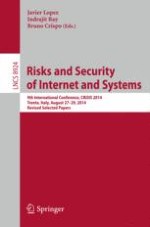2015 | Buch
Risks and Security of Internet and Systems
9th International Conference, CRiSIS 2014, Trento, Italy, August 27-29, 2014, Revised Selected Papers
herausgegeben von: Javier Lopez, Indrajit Ray, Bruno Crispo
Verlag: Springer International Publishing
Buchreihe : Lecture Notes in Computer Science
